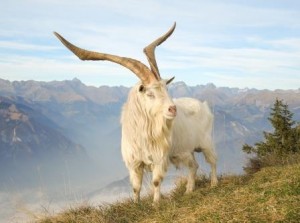Understanding goat behaviour
Providing animals with conditions that enable them to exhibit natural behaviours is one of our key principles. For goats, some of these behaviours may appear obvious, such as those associated with living outdoors and having access to natural feeds. Others are less so, such as the way goats behave at key stages of their reproductive cycle e.g. mating or at birth, or how they organise themselves socially. In order to provide the conditions and management that enable goats to live a fulfilling and healthy life that is balanced with meeting our own social, environmental and economic demands, we need to gain a basic understanding of some of these key behaviours. In this page, we introduce some key observations and knowledge about how goats behave, and provide links to further resources and knowledge sources.
Social behaviour
Goats are more aggressive than sheep. Whereas sheep tend to be fearful and shy and flee from attackers, goats are more exploratory and reactive and tend to face their attackers when threatened (Miranda-de la Lamaa and Mattiellob, 2010). Fighting behaviour of sheep and goats is closely related to their horn structure and horn size is an indicator of social rank (Shackleton and Shank, 1983).
Just like most ungulate species, goats show a high level of social organization, which allows better protection from predators, more effective foraging, better access to sexual partners and successful care and protection of offspring (Miranda-de la Lamaa and Mattiellob, 2010).
Social organization
Goats are social creatures normally found in groups and it is recommended that they are not kept in isolation, at least for any length of time. Once formed, the group social structure can last for years. A clear, stable, linear hierarchy exists within groups and the most hierarchical position tends to be the most aggressive. When forage is available, there are differences in the diet between dominant and subordinate animals that disappear during shortages of forage.
Dominance within the group is in part dictated by age and body and horn size. Interestingly, those in the middle range of hierarchy tend to be the most productive (Barraso et al., 2000).
Typical group sizes can vary enormously, from 4 to 300! Under natural conditions, the size of a group will be determined by the nature of the surrounding vegetation or the ‘ecological niche’. In open savanna environments, the group size will be largely than those found in thicker vegetation.
Isolation causes stress!
In their natural environment goats are rarely found alone and forced isolation can be stressful (Kannan et al., 2002). Forced isolation of pregnant females, especially during transport, can have lasting behavioural effects on their offspring (Duvaux-Ponter et al., 2003; Roussel et al., 2005). If females have to be isolated before they give birth, it is better to create small groups of other pregnant females or to isolate them but to allow the opportunity to smell, see and hear others from the same group (Miranda-de la Lamaa and Mattiellob, 2010).
Sight, sound and smell signals
Smell, sight and sound are important signals to bucks in detecting in-heat females. Olfactory (smell) signals are more important in goat flocks than they are in sheep, especially those relating to sexual and maternal behaviour. Introducing males into a flock of seasonally anoestrus females causes a phenomenon known as “the buck effect” (the “male effect” also exists among sheep) which results in secretion of luteinising hormone in the females and synchronized ovulation (Gelez and Fabre-Nys, 2004). See also Reproduction
Goats urinate frequently and this is one of the main signals of individual identity and goats, especially in relation to reproductive status. They also secrete smell signals via pedal glands and a tail gland.
Male goats perform flehmen behaviour in the presence of females as a response to receiving non-volatile smells (pheromones). This is a response seen in a number of animals that involves exposure of the front teeth by curling back the upper lip and closing the nostril. This facilitates the passage of non-volatile materials (pheromones) from the oral cavity to the vomeronasal (Jacobson’s) organ (Ladewig and Hart, 1980), which then prompts natural reproductive behaviour.
Goats are enthusiastic vocalizers!
They adopt a range of noises for various purposes, including bleating, snorting and sneezing. As well as smell recognition, does develop sight and sound recognition of their new-born kid within 4 hours of giving birth. There is sufficient difference between the bleating sound of individual kids to enable dams to recognise offspring based solely on sound (Terrazas et al., 2003). Kids also use distress calls and isolation bleats to alert their mother of their whereabouts. The sounds that kids make vary with age, sex and body size and can be used to provide information about the physiological status of the animal (Briefer and McElligott, 2011).
Smell is also an important route through which adults and their young develop a bond. Mothers actively lick their young immediately after birth and very quickly establish a bond through smell recognition (Poindron et al., 2007a). The strength of this maternal recognition can be negatively affected if the doe is underfed during the second half of pregnancy. Although kids tend to hide during the first week of life, whereas lambs follow their mothers very soon after they are born, the mechanisms that control the onset of maternal behaviour and bonding appear to be the same in both species (Poindron et al., 2007a). Awareness of the importance of smell during the early hours is key as disruption of this stimulus can cause rejection.
Dam-offspring relationship
During the first week of life a kid will be completely dependent on its mother and will be sucking milk ad libitum. Between weeks 2 and 5, whilst still largely dependent on milk, the mother will increasingly start to reject attempts to suckle and after this period the kid will become increasingly dependent on other foods (Bungo et al., 1998; Miranda-de la Lamaa and Mattiellob, 2010).).
With regard to their behaviour, they exhibit patterns of dam-offspring interaction that resemble those ungulate species that have a “hider” type of mother-infant relationship as compared with sheep, who have a “follower” type of dam-infant relationship. Early infant behaviour generally involves less early interaction with the mother and during 15 weeks after birth, kids often associate more with others of a similar age, not just their siblings. These peer groups can form as early as the end of the second week. In feral herds, young goats form large groups or “creches” of different aged animals of both sexes, separate from their mothers. Over time, kids spend increasingly more time on activities synchronised with their mother (Lickliter, 1987).
In extensive systems, where kids will be left to suckle their dams, it is important to avoid disturbing the animals during the very early sensitive period following birth. Maternal behaviour is strongly associated with the moment of birth, and in systems where kids will remain suckling their mothers (Lickliter, 1982), it is best not to disturb them during this time. Studies show that when a goat is left undisturbed with her kid after kidding, maternal selectivity is developed within hours i.e. the kid is recognized by its own dam whereas other kids from other dams are rejected. There are some breed differences in the length of this critical period without disturbance, but is likely to be no more than 4 hours and can be as short as 1 hour i.e. the new born kid should not be disturbed during this time. This period is significantly shorter than that recorded for sheep and cattle. Although a very brief short contact immediately after birth i.e. 5 minutes has been shown to extend the period of separation before maternal selectivity is lost (Ramírez et al., 1996).
Breeding behaviour
Please visit the section on Goat Reproduction for information on behaviour during breeding.


 American English
American English


Comments are closed.